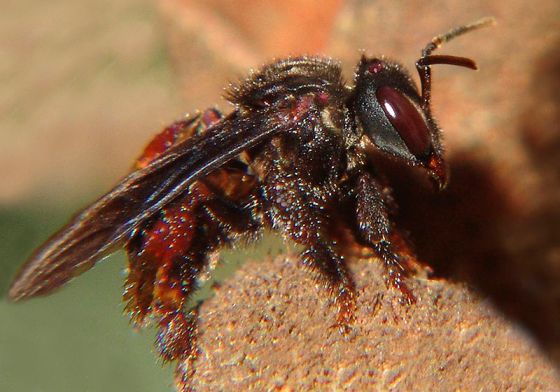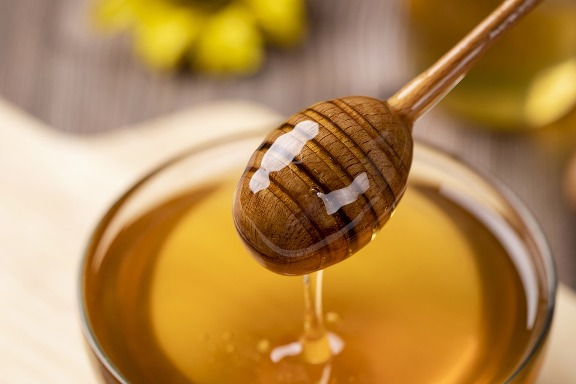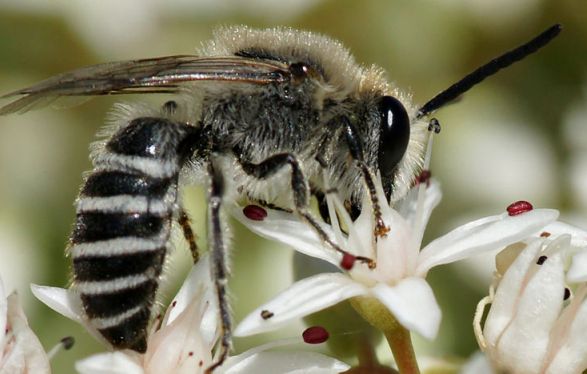We’ve all eaten honey at some point in our lives.
We all also tend to assume that we know how honey is made: some poor bee goes from flower to flower to flower collecting nectar, and then transforms it into the gorgeous thick golden liquid that we find so irresistible.
But what if I were to tell you that vulture bees are different? They swap nectar for meat to ‘make’ honey!
Now, I’m being a bit melodramatic here: this docile, harmless bee isn’t going to hunt you down to feed itself.
In fact, this particular bee won’t touch living animals as far as possible; for it prefers its meat to be dead on arrival.
Sure your mind is rattled with questions: what exactly are vulture bees, do they make honey, is that honey edible, what’s the whale meat bartering system, and more. I’ll answer them all.

Huh? Meat-eating bees?
Don’t worry, it’s a common misconception (one that I used to have myself) that bees are solely a nectar-consuming species.
There’s a good chance that you’ve seen the film called “Bee Movie” by Dreamworks animation studios.
The picture’s star character was Barry B. Benson, a worker bee fresh out of college with one career choice: to make honey.
It’s a similar story with literally every single type of bee in the world: the worker bees in each colony make honey for use by the hive.
Every bee has a similar recipe for making its precious honey: the worker bees first ingest (eat) some sort of plant protein (in our case, animal protein).
The worker bees then deliver this protein to “indoor” bees inside the hive who pass it mouth to mouth until the moisture content of the protein is reduced from 70% to about 20%.
The main difference is this: the bees we’re used to seeing are honey bees, whereas we are talking about vulture bees.
What the hell is a vulture bee?
Mighty interesting.
When I say the word “bee”, you picture a bumbling yellow insect hovering about, looking for flowers, right?
Not this one. Vulture bees are rather peculiar, in the sense that they prefer carrion (dead animal meat) to the more mainstream choice of flower nectar.
They have developed special tooth-like points in their jaws that help to strip the meat from the bone in small animals (because tearing meat is significantly harder than lapping up pollen).
Why are bees attracted to meat?
Well you see, the places that these bees call home aren’t very hospitable.
The vulture bee likes to deliberately make its life difficult by living in areas where no or very few flowers grow.
So now what is the poor bee to do? It still needs some sort of organic protein source to make its honey, right?
That is why it turns to the next most common source of protein: meat. This bee is from the “Trigona” genus, meaning that it has no stinger.
Translation: vulture bees cannot hunt their prey, so they have to rely on carrion as their main source of food.
When a scout bee finds a food source (like a deceased animal or rodent), it releases a unique pheromone so that the other members of the hive know where to find it.
Conclusion: these bees cannot easily access pollen, but pollen is vital to the developing young bees who will later be running the hive when these current adults migrate.
The meat from carrion replaces/ substitutes the protein that other species of bees get from pollen, so as not to hinder their development.
Fact: a vulture bee will actively chase away any flies that are on the carcass it finds, so that there is more for the rest of the hive.
Do vulture bees make honey?
Yes, they do, but you wouldn’t want to eat it. Why? What does vulture bee honey taste like exactly?
Well for one, vulture bee honey is one of the most gooey and thick forms of honey in the world, and isn’t too sweet either. In fact, it’s rather unsweet to human taste buds.
Now, honey bees have a nice life for themselves: they produce lots (and I mean lots) of extra honey, more than they or their hive will ever need.
Their cousins (the vulture bees), on the other hand, struggle to produce enough honey for themselves, let alone the rest of them.
This means that collecting vulture bee honey is not only hard but also impractical.
Adding to that, their honey doesn’t taste too good to humans either, because our tummies don’t agree with the animal proteins in their version of honey.

What does vulture bee honey look like?
Here’s a fun fact: pure, natural honey isn’t golden in color at all; it’s more of a deep brown. The golden color comes out during the processing of the honey for the market.
Also, side note, there are a lot of fake honey makers labeling their products as natural.
Quick test: add a couple drops of vinegar to your honey. If it starts to foam, it’s not natural and is probably chemically enhanced.
This is because natural honey does not react to vinegar or most mild acids. Coming to the answer: vulture bee honey is also a deep brown color.
Another thing to note is that though vulture bees store their honey in boxes like honey bees, they also sometimes put a larva inside each “honey pot”.
Where do vulture bees live?
Well, the short answer is: North and South America. You’ll find these little dudes all the way from Panama, to Guiana, to the Amazon Basin, to Utah.
Coming to the question of where vulture bees are found, there are three types of vulture bees, and they all belong to the genus “Trigona”. Depending on which one you’re looking for, you’d have to adjust yourself geographically too.
Now, these vulture bees (so called because vultures also like carrion) are a rather recent discovery, first documented about 1992, two centuries after bee cultivation was first started.
This is why there is very little information available about them.
However, I am passionate about all kinds of bees, whether useful to man or not, because every bee is useful to nature in some way.
Is vulture bee honey safe to eat?
Technically, yes it is. The human digestive system has the enzymes needed to successfully break down the complex compounds in a vulture bees’ honey.
The real question, however, is why would you want to?
The honey is stickier than the one you’re probably used to, it’s rather viscous in fact, and tends to be extremely hard to collect.
Also, remember what I said earlier about vulture bees not making any surplus honey?
That’s right, if you do manage to successfully extract some honey from them, their young would have nothing to eat and would die.
That is why vulture bees are well left alone, so live and let live!

Do vulture bees bite?
This, I believe, is the question of the hour for most of you reading this article.
Like I said earlier, vulture bees are from the Trigona genus of bees, meaning that they are stingless bees.
That said, however, a lot of trigona bees are known to have a powerful (and painful) bite, but because of the lack of information on vulture bees, I cannot be sure about it.
The one thing I can be sure about is that like all other bees, a vulture bee, and its swarm will not attack unless provoked.
Even the infamous killer bee will not go out of its way to hurt a human. But still, you know, don’t chuck a rock at a nest if you see one.
Vulture bees: A quickie
Vulture bees are a newly discovered type of bee from the genus “trigona”, meaning that they do not have a stinger.
However, it is suspected that they have a potent bite, but this is unverified due to a lack of information.
These bees feed exclusively on carrion and are predominantly found in North and South America, in varying sizes.
To facilitate the eating and storing of meat, each bee has developed five or more “teeth” in their upper jaw, because eating meat is harder than drinking nectar.
They need to eat meat because they live in areas where flowers do not blossom, and even when they do, it’s for a limited, seasonal period.
The bees have a special enzyme that mixes with meat compounds to break the meat down into a pasty goo that can easily be stored in the bee’s crop (yum!)
By the way, a “crop” is another word for the “honey sack” or “honey pouch” of a worker bee, which is where it stores its “raw materials” until it can get back to the hive to process them into honey.
Vulture bees do not make excess honey like their cousins (the honeybees), and even if they did, humans would likely not want to eat it.
From the limited data known to scientists, these seem to be a rather docile type of bee, hardly ever engaging in conflict, even internally.
Scientists are a bit hopeful that some more potent medicinal properties may come from the honey of vulture bees, but there still isn’t a way of harvesting it properly.
It’s worth noting that these bees are extremely unlikely to favor your garage for their nest as they like to be near places where carrion is frequently available.
And with that, I’ll conclude my piece by saying that you should think of these not as pests, but rather as friendly neighborhood zom-bees.
Read here: